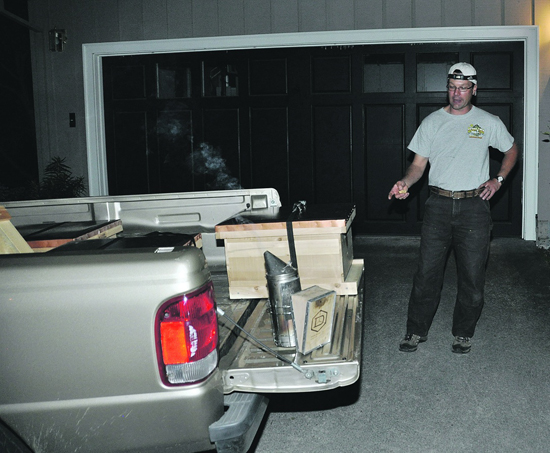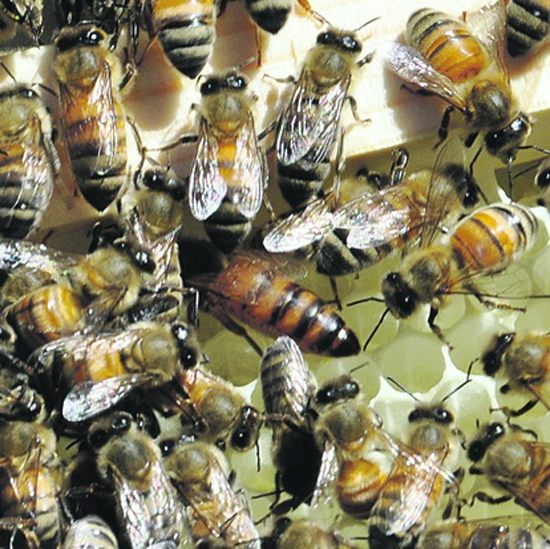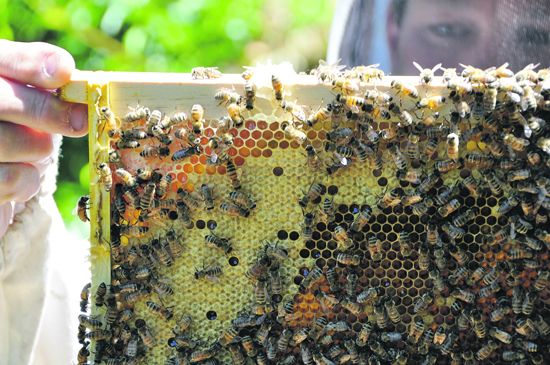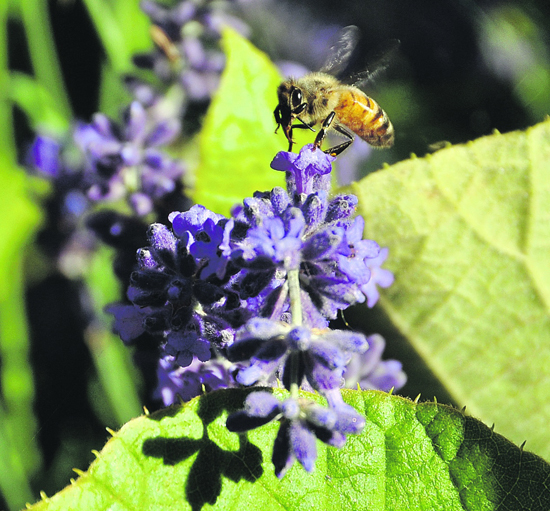 | | | Mike Vigo delivers Bees at night Photos Andy Scheck
| | | | | | What backyard gardener doesn't like a good buzz? From bees, of course. Now even neophyte horticulturalists can enjoy the benefits of bees without having to actively manage a hive - and reap a bounty of honey in return for the "rent." Enter Mike Vigo, Orinda resident, former securities broker, trader and principal at 033 Asset Management, Robertson Stephens and Montgomery Securities. The full time "Bee Rancher" has brought his business acumen and very unique hive concept to backyards throughout Lamorinda.
 It all started with a 4H project that his three girls were involved in four years ago; the family learned what it takes to manage healthy, happy bees from the ground up. Friendly, personable Vigo was ready for a change at work and saw the bee business as a golden opportunity, noting key similarities in both service oriented businesses: "It's all about maintaining and fostering relationships." Armed with an Agriculture Business Management degree from Cal Poly San Luis Obispo, a beekeeping software program, diligently updated spreadsheets and electronic notes on each and every hive, he's applying lessons learned in the securities business to managing The Bee Ranchers.
It all started with a 4H project that his three girls were involved in four years ago; the family learned what it takes to manage healthy, happy bees from the ground up. Friendly, personable Vigo was ready for a change at work and saw the bee business as a golden opportunity, noting key similarities in both service oriented businesses: "It's all about maintaining and fostering relationships." Armed with an Agriculture Business Management degree from Cal Poly San Luis Obispo, a beekeeping software program, diligently updated spreadsheets and electronic notes on each and every hive, he's applying lessons learned in the securities business to managing The Bee Ranchers.
 Word of the local enterprise has spread from friends and family and beyond. He now manages over 50 hives - one has landed in the backyard of Wendy and Andy Scheck, organic gardeners and the publishers of this newspaper. Like proud new parents, they were up early on the morning after their initial bee installation checking on the new arrivals.
Word of the local enterprise has spread from friends and family and beyond. He now manages over 50 hives - one has landed in the backyard of Wendy and Andy Scheck, organic gardeners and the publishers of this newspaper. Like proud new parents, they were up early on the morning after their initial bee installation checking on the new arrivals.
 Delivery and set up of the Scheck's lovely cedar hive took place in the evening; Vigo was well prepared with a headlamp to navigate through the backyard carrying the components of the hive. No drama, no gloves - the install went off without a peep from the occupants.
Delivery and set up of the Scheck's lovely cedar hive took place in the evening; Vigo was well prepared with a headlamp to navigate through the backyard carrying the components of the hive. No drama, no gloves - the install went off without a peep from the occupants.
 "Day one is always special," said Vigo describing the orientation flight of the hive foragers. "They have GPS (global positioning system)" - or as fellow staff writer Cathy Dausman points out - "Bee PS." The bees need to get the lay of the land - eventually cruising up to three miles away to forage before coming home at dusk.
"Day one is always special," said Vigo describing the orientation flight of the hive foragers. "They have GPS (global positioning system)" - or as fellow staff writer Cathy Dausman points out - "Bee PS." The bees need to get the lay of the land - eventually cruising up to three miles away to forage before coming home at dusk.
 Scheck was up early enough to see the first bee come out at 6:50 a.m. May 9, noting that a brave explorer and friend landed on the ground and stopped moving. "I wasn't sure if they died or if it was still too cold for them to make it back," he said. By 10 a.m., he reported some had made it to the lemon tree and other nearby flowers. "By eleven, lots of activity all around and many had found the lemon tree." In the ensuing days, there were more and more flights as the residents got settled into their new home.
Scheck was up early enough to see the first bee come out at 6:50 a.m. May 9, noting that a brave explorer and friend landed on the ground and stopped moving. "I wasn't sure if they died or if it was still too cold for them to make it back," he said. By 10 a.m., he reported some had made it to the lemon tree and other nearby flowers. "By eleven, lots of activity all around and many had found the lemon tree." In the ensuing days, there were more and more flights as the residents got settled into their new home.
 So far, so good, just over a month into their tenure at the Scheck's house, the Bee Rancher has been back periodically to check on the hive and make sure the queen is laying eggs, to watch out for pesky mites and to verify the bee's progress - apparently they don't like being too constrained. Their garden is thriving, flowers and trees are buzzing with bee activity, and it looks like only one sting to their sweet, inquisitive Golden Retriever. The dog's not explaining if she tried to eat one of the new honeybee guests, or if it was a cranky yellow jacket.
So far, so good, just over a month into their tenure at the Scheck's house, the Bee Rancher has been back periodically to check on the hive and make sure the queen is laying eggs, to watch out for pesky mites and to verify the bee's progress - apparently they don't like being too constrained. Their garden is thriving, flowers and trees are buzzing with bee activity, and it looks like only one sting to their sweet, inquisitive Golden Retriever. The dog's not explaining if she tried to eat one of the new honeybee guests, or if it was a cranky yellow jacket.
 Picking the right location is good for houses, and good for hives. Morning light is preferable for the hive - to gradually warm the hive with entry and exit toward the back - so the bees don't get spooked when they sense a person coming to check up on them. With a mini-front porch that seems to serve as a landing strip, the 8,000 bees manage getting in and out just fine, going about their business pollinating.
Picking the right location is good for houses, and good for hives. Morning light is preferable for the hive - to gradually warm the hive with entry and exit toward the back - so the bees don't get spooked when they sense a person coming to check up on them. With a mini-front porch that seems to serve as a landing strip, the 8,000 bees manage getting in and out just fine, going about their business pollinating.
 With sophisticated gardeners, prime habitat, an abundance of fruit trees and tons of interest in colony collapse, Lamorinda residents have embraced the hive management concept. The Bee Rancher did his homework and offers two services: Hive hosting for those who want to help out the honeybee - where the Bee Rancher owns the hives, the bees and honey, and then sells the proceeds through his wife, Jennifer Vigo's shop ReChic Boutique 101 in Orinda. Homeowners get up to two pounds of honey per extraction - usually twice per year, and their own personal backyard pollinators. For the 2012 season, all of the hive-hosting colonies have been placed, but Vigo can keep interested parties on a list for next year.
With sophisticated gardeners, prime habitat, an abundance of fruit trees and tons of interest in colony collapse, Lamorinda residents have embraced the hive management concept. The Bee Rancher did his homework and offers two services: Hive hosting for those who want to help out the honeybee - where the Bee Rancher owns the hives, the bees and honey, and then sells the proceeds through his wife, Jennifer Vigo's shop ReChic Boutique 101 in Orinda. Homeowners get up to two pounds of honey per extraction - usually twice per year, and their own personal backyard pollinators. For the 2012 season, all of the hive-hosting colonies have been placed, but Vigo can keep interested parties on a list for next year.
 The second option is "a lot like a pool guy," says Vigo. The homeowner owns the hive, the honey and the bees and he just comes to service it and manage the harvest. A third component of the business is his custom metal hive stands. "I collect used bedframes, and re-purpose them to keep the hives from eight to twelve inches off the ground," he said. Results have been good so far. Now on version 2.0, the stands have extra long legs because of the uneven terrain of the area.
The second option is "a lot like a pool guy," says Vigo. The homeowner owns the hive, the honey and the bees and he just comes to service it and manage the harvest. A third component of the business is his custom metal hive stands. "I collect used bedframes, and re-purpose them to keep the hives from eight to twelve inches off the ground," he said. Results have been good so far. Now on version 2.0, the stands have extra long legs because of the uneven terrain of the area.
 Over the summer Vigo's ranch hands, his girls -the oldest is now 16 - will help tend to the herd of 50-plus hives and will pitch in for the honey harvest, of course when they're not busy with sports and friends. Vigo will be out on the range visiting hives - roughly twice per month from March through October. For more information, visit www.thebeeranchers.com.
Over the summer Vigo's ranch hands, his girls -the oldest is now 16 - will help tend to the herd of 50-plus hives and will pitch in for the honey harvest, of course when they're not busy with sports and friends. Vigo will be out on the range visiting hives - roughly twice per month from March through October. For more information, visit www.thebeeranchers.com.

 Attack of the Vampire Mite?
Attack of the Vampire Mite?
 Varroa Destructor external parasitic mites attack honey bees and can replicate in a honey bee colony and suck the "blood" or hemolymph of adult honey bees and leave open wounds which are prone to infection. Adult bees are almost completely defenseless against these parasites. This reddish brown teeny pest is only 1 - 1.8 millimeters long, and 1.5 - 2 millimeters wide; but the eight legged mini-beast can wreak havoc in a hive, since they reproduce on a 10 day cycle.
Varroa Destructor external parasitic mites attack honey bees and can replicate in a honey bee colony and suck the "blood" or hemolymph of adult honey bees and leave open wounds which are prone to infection. Adult bees are almost completely defenseless against these parasites. This reddish brown teeny pest is only 1 - 1.8 millimeters long, and 1.5 - 2 millimeters wide; but the eight legged mini-beast can wreak havoc in a hive, since they reproduce on a 10 day cycle.

 Why are bees disappearing?
Why are bees disappearing?
 "Beginning in 2006, beekeepers in the United States began to report unexplained losses of hives - 30 percent and upward - leading to a phenomenon called colony collapse disorder (CCD). The cause of CCD remains under debate, but scientific consensus is beginning to emerge suggesting that there is no one cause but rather a combination of factors including lack of foraging plants, infections, breeding, and pesticides--with none catastrophic on their own, but having a synergistic effect when occurring in combination," writes Wikipedia with sources noted as New Scientist, Environmental Microbiology and BBC News.
"Beginning in 2006, beekeepers in the United States began to report unexplained losses of hives - 30 percent and upward - leading to a phenomenon called colony collapse disorder (CCD). The cause of CCD remains under debate, but scientific consensus is beginning to emerge suggesting that there is no one cause but rather a combination of factors including lack of foraging plants, infections, breeding, and pesticides--with none catastrophic on their own, but having a synergistic effect when occurring in combination," writes Wikipedia with sources noted as New Scientist, Environmental Microbiology and BBC News.
 One possible component of CCD is clothianidin, developed by Takeda Chemical Industries and by Bayer AG. This particular insecticide is chemically similar to nicotine, which has been used as a pesticide since the late 1700s. The Environmental Protection Agency describes clothianidin's major risk to non-target insects - honeybees. Studies suggest the potential for long term toxic risk to honeybees and other beneficial insects according to the Congressional Research Service Report for Congress on Honey Bee Colony Collapse Disorder.
One possible component of CCD is clothianidin, developed by Takeda Chemical Industries and by Bayer AG. This particular insecticide is chemically similar to nicotine, which has been used as a pesticide since the late 1700s. The Environmental Protection Agency describes clothianidin's major risk to non-target insects - honeybees. Studies suggest the potential for long term toxic risk to honeybees and other beneficial insects according to the Congressional Research Service Report for Congress on Honey Bee Colony Collapse Disorder.
 The Australian Pesticides and Veterinary Medicines Authority notes that clothianidin ranks "among the most highly acutely toxic insecticides to bees" through contact and oral exposure.
The Australian Pesticides and Veterinary Medicines Authority notes that clothianidin ranks "among the most highly acutely toxic insecticides to bees" through contact and oral exposure.

|




